With a few meters to go at the Leadville 100, Keegan Swenson could have come to a stop, laid on the ground, and taken a 15-minute nap. He still would have had 15 seconds to remount his bike and cross the finish line before John Gaston came across the line. After that, the pair could have waited seven more minutes for third place, Simon Pellaud, or an additional 15 minutes for the rest of the top 10.
In other words, the time gaps at the Leadville Trail 100 MTB were absolutely massive. They were so big that Swenson questioned his own tactics after the race. Had he realized that he was two minutes behind course record pace, he probably would’ve backed off.
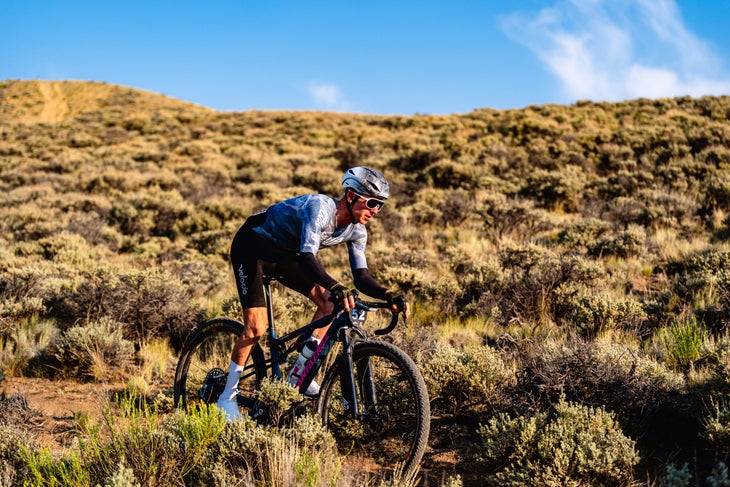
But he didn’t, and for the fifth time in his career, Swenson won the Leadville 100. Kate Courtney won the Leadville 100 elite women in her debut at the race, finishing 10 minutes ahead of Melisa Rollins, while Cecily Decker rounded out the podium after the post-race disqualification of Lauren Stephens.
There are a million story lines every year at Leadville, but in this article, we’re going to focus on the high-altitude performances of Swenson and Courtney. Is Swenson as strong as he was before, or are the course conditions to blame for his slower finishing time? And when it comes to Courtney, could this be a sign of incoming gravel domination, or was it a one-off on a unique MTB course?
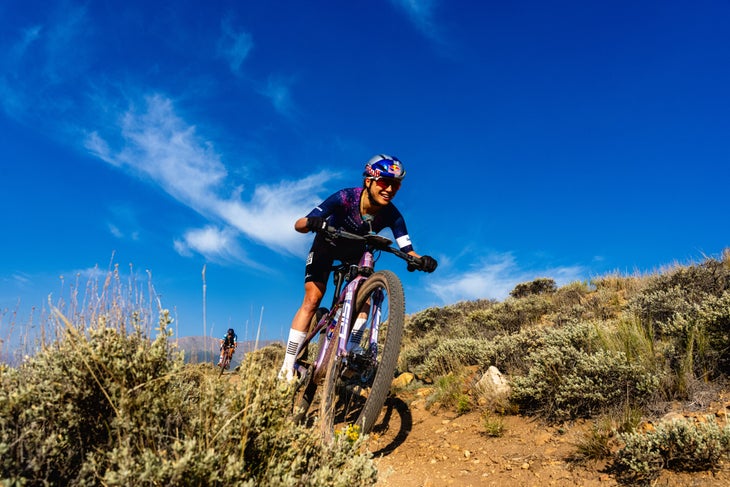
Let’s take a closer look.
Power Analysis: Leadville Trail 100 MTB
The Leadville Trail 100 MTB is one of – if not the – highest bike races in North America. Beginning at 10,152 feet in Leadville, Colorado, the Leadville 100 hits a peak of 12,424 ft at the summit of Columbine at the race’s turnaround point. Columbine is a 7.8-mile climb with an average gradient of 8.2%, and it is literally and metaphorically the turning point of the race.
Leadville’s high altitude makes it a completely unique race. Few riders live at 10,000 feet, let alone race to 12,000 feet and beyond. A typical high-altitude training camp would be held between 6,500 and 8,000 feet. At Leadville, we are talking about the extremes – off the charts territory when it comes to high-altitude training and physiological performance.
If you cannot perform at high-altitude, you will not do well at the Leadville 100. In fact, you might not even finish.
The 10,000-foot start line was part of the reason that the Leadville 100 began in ice cold conditions. According to Swenson’s and Courtney’s bike computers, the air temperature was 23-32°F during the first 30 minutes of the race. But that didn’t stop Swenson from dropping nearly the entire field with over five hours to go.
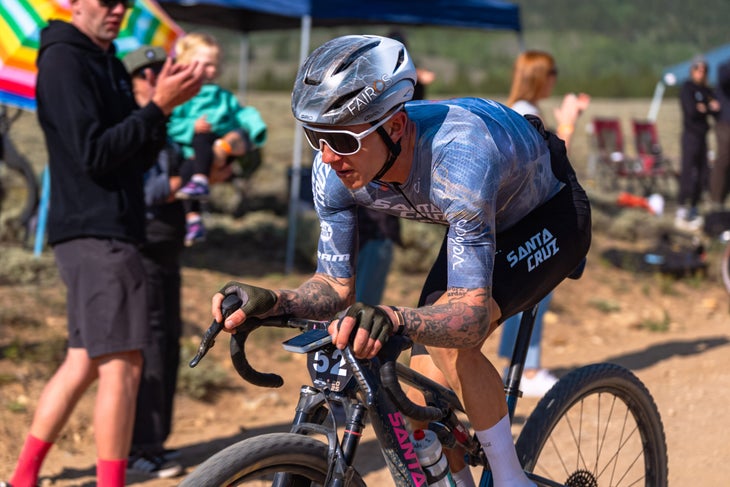
Only John Gaston and Simon Pellaud were able to follow the defending champion, and they were taking big risks to do so. This was Pellaud’s peak 10-minute power for the entire race: 381w (5.4w/kg). I should also point out that throughout this article, I will be posting the sea-level equivalent power outputs for each effort. According to multiple studies, cycling power output is said to decrease, on average, by about 1% per 1000 feet of elevation gain. The effect seems linear until around 5,000-6,000 feet, where the power drop-off becomes even more substantial.
Of course, these numbers vary based on genetic factors, training history, acclimation status, and more. But with all things considered, no one is doing their best-ever power numbers at high-altitude – let alone 10,000 to 12,000 feet. These data suggest that, at best, the pros’ power outputs are 80-85% of their sea-level potential at the Leadville 100. Keep that in mind once we dive into the numbers.

Pellaud – First Climb of the Leadville 100
- Time: 10:00
- Average Power: 381w (5.4w/kg)
- Sea Level Estimated Equivalent: ~460w (6.6w/kg)
Swenson: 9:59 at ~5.5w/kg
It was clear that Swenson was going for the course record, so he continued to push the pace all the way to Columbine. Gaston and Pellaud were happy to contribute to the effort, and it wasn’t long before the trio had put minutes into the chase group.
Two and a half hours into the race, the leaders began the longest climb in the race: Columbine. With an average gradient of 8.2% and peak altitude of 12,424 feet, Columbine takes the fastest riders in the world nearly an hour to summit. Pellaud finished the climb in about 51 minutes at an average power of 312w (4.5w/kg). But this is where Swenson sets himself apart.
Swenson climbed Columbine in 45 minutes and 54 seconds with an average power of 5.2-5.3w/kg. It’s difficult to say exactly where the Columbine segment begins and ends, but it looks like Swenson climbed Columbine roughly 30 seconds slower than in 2023, where he posted his fastest ascent of the climb. When adjusted for altitude, we are talking about power numbers well over 6w/kg for 45 minutes.

Pellaud – Columbine
- Time: 51:21
- Average Power: 312w (4.5w/kg)
- Sea Level Estimated Equivalent: ~385w (5.5w/kg)
Swenson: 45:54 at ~5.3w/kg
- Sea Level Estimated Equivalent: ~6.4w/kg
Courtney put in a similar effort on Columbine, dropping the lead group of elite women and posting one of the fastest climbs of the day — men or women. In fact, Courtney’s time of 55:30 is the 12th fastest time on the Columbine Strava segment in 2025. She was faster than Unbound Gravel Champion Cameron Jones, as well as Payson McElveen who would go on to finish fifth in the elite men’s Leadville 100.

Courtney – Columbine
- Time: 55:30
- Estimated Average Power: ~3.8w/kg
- Sea Level Estimated Equivalent: ~4.9w/kg
After Columbine, it was all about the course record for Swenson. Unfortunately, the conditions did not agree with the sentiment. The dirt and gravel were slower than in previous years, and Swenson was losing time on every descent.
On top of that, Mother Nature was not in a record-breaking mood and she greeted Swenson with a headwind for the final part of the race. Nevertheless, Swenson continued pushing under the belief that he was two minutes faster than record pace. But Swenson said afterwards that he was suffering from race brain in those final miles – he was actually two minutes behind record pace.
With over 4,000 kJs in the legs, Pellaud was beginning to crawl up the climbs in third place on the road. He still had a 10-minute gap to the next group on the road, but we can see from his power file that he was suffering from his earlier efforts on Powerline. The second-most famous climb in the Leadville 100 is Powerline, a 3.5-mile climb with an average gradient of 7.6%. Typically, you could make a decisive move on Powerline with only 27 miles to go. But with nearly 15 minutes in hand, Swenson was on cruise control.
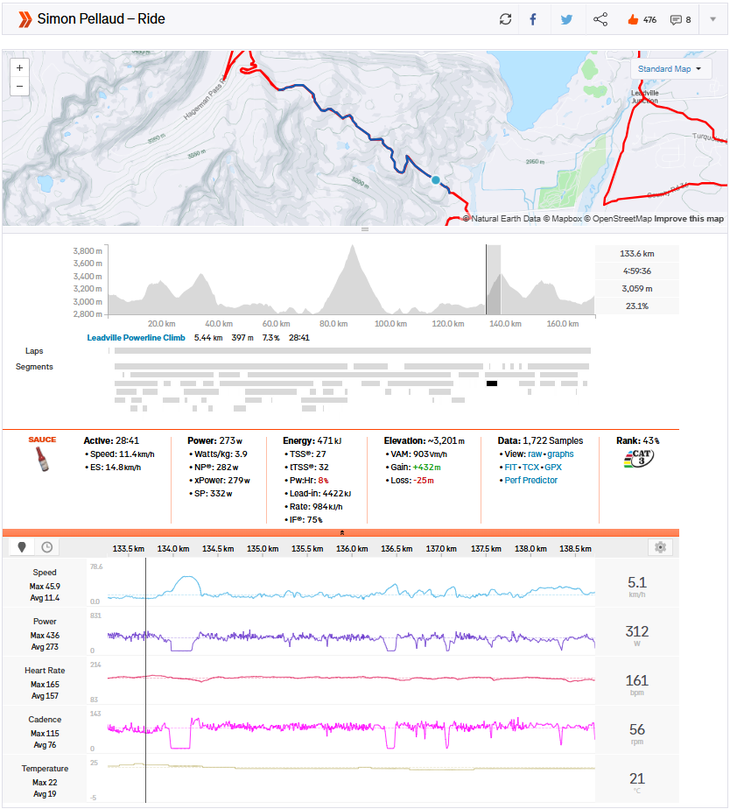
Pellaud – Powerline
- Time: 28:41
- Normalized Power: 282w (4.1w/kg)
- Sea Level Estimated Equivalent: ~332w (4.8w/kg)
Swenson: 24:21 at ~4.8w/kg
- Sea Level Estimated Equivalent: ~5.9w/kg
Despite pushing as hard as he could, Swenson couldn’t make up time into the final miles of headwind. Finishing with a time of 5 hours 45 minutes and 35 seconds, Swenson won the Leadville 100, but missed the course record by two minutes. Gaston crossed the line in second, while Pellaud hung on for third.
Courtney had a similar Leadville 100 experience, going solo from the climb up Columbine. She went on to stop the clock at 6:48:55, setting the course record by more than 10 minutes over the previous mark set by Annika Langvad in 2015. Meilsa Rollins finished second, clocking a sub 7-hour time with 6:59:16.
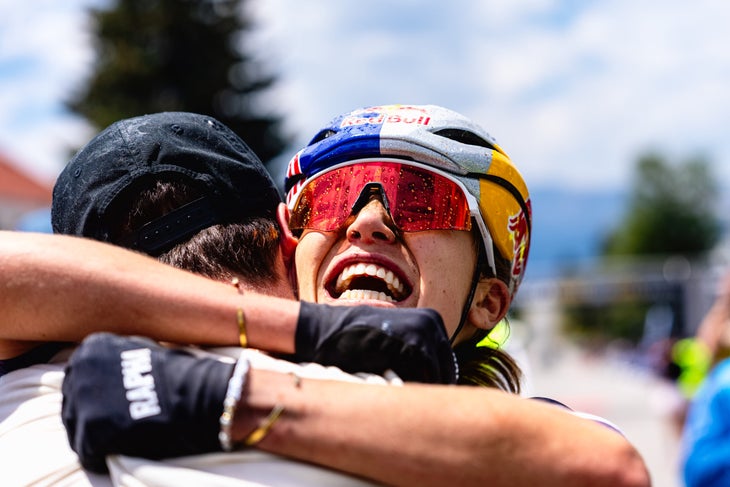
Lauren Stephens had won the battle for third, but she was later disqualified for “taking aid outside of a designated crew location.” Thus, Cecily Decker moved onto the podium.
Power Analysis data courtesy of Strava
Strava sauce extension
Riders:
